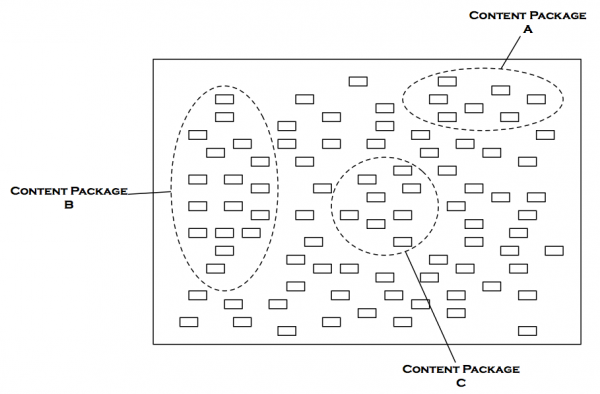A content package is a collection of content items. Content packages are a convenient way to group of bunch of content items together and distribute them, in the much the same we zip up files and share the zip. Convenience!
There are many different ways to create content, from within a CMS to your favourite mobile application. It doesn’t really matter how content is created, but once it has been created, we often need to group content items together into coarser grained, more manageable collections (think zip files). Those collections are called content packages.
Content Packages store Content Items.
Remember, content items are created from content types by a process known as instantiation. During instantiation, a content item copies its structure from the content type and assigns all the supplied values to each of its content attributes. Now consider the diagram below that depicts a content repository full of content items instantiated from blog post and pages WordPress content types.
We decide to create three content packages:
- Content Package A: Blog post and pages that are more than two years old
- Content Package B: Blog posts that were written by Barry White
- Content Package C: Just pages
Content packages deal in content items only. There is not a content type in sight. Like content items, content packages are tangible, runtime artefacts in content-based applications. They are not organising, design-time constructs like content types and content modules.
Simple and Dynamic
Back to our example. Every morning at 06:00 we decide to expire all blog posts and pages older than two years old. So we dynamically create content package A, every morning, send it over to downstreams systems to archive and notify the editorial team, before we expire them. The ability to dynamically create content package A and throw it about the system is a very powerful concept in content management.
We could run different rules to create content package B and send that off to get Barry White blog posts translated into Spanish and Germany. The point being that content packages are simply buckets of content items that can be dynamically assembled for subsequent processing by something, somewhere, at sometime in the future. We don’t care what or when. We just know that with content packages we have the delivery format.
Summary
A content package represents a subset of the content items created and stored within the content repository. Content packages are created to meet a specific need, and more increasingly on-demand. They are becoming critical for delivering personalised content-driven experiences, where the rules for packaging content items are infinite. The content package is an essential vehicle for the effective distribution of content at scale and at speed.
Where next?


